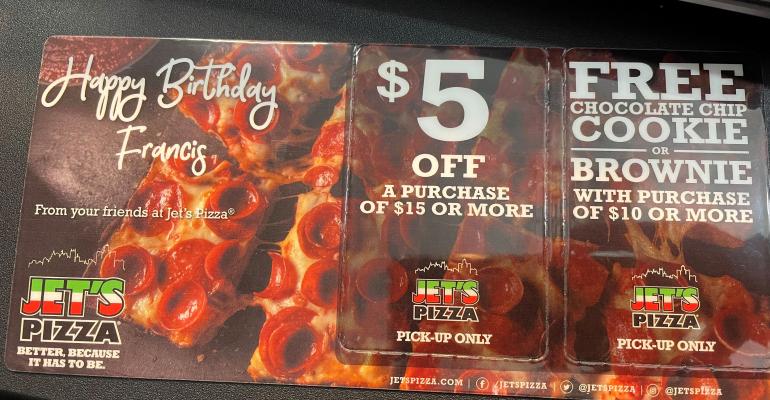Restaurant companies are shifting their marketing resources back to the local level. At least some of them are.
According to the Harvard Business Review, more marketers have started to look for ways to cut through the digital clutter that has been accumulating since about 2012, and direct mail and local/guerilla marketing are effective tactics. Consider one survey of Millennials from USPS, for instance, finding that 75% of respondents said receiving personal mail makes them feel special. Or, a survey from Hubspot, which finds most people don’t like digital video ads, while 43% have never watched them.
“We’re going back old school and bringing on a local store marketing plan. It’s just going to be grassroots guerilla marketing at the store level because we see so much competition for search engine marketing. We’ve all been spending all this money for the same real estate on search engines and we have found we’re more effective with more direct, localized marketing,” Chuck Imerson, CEO of Asian Box, said during a recent interview.
Asian Box isn’t alone in finding such effectiveness. Red Robin CEO GJ Hart has talked at length about moving to a more localized marketing strategy since coming on board last year.
“Red Robin was the original leader in local marketing, and we will drive to return to our local marketing routes,” he said during the company’s Q1 call in May, noting that such efforts generate more loyal guests who visit and spend more.
Such loyalty is driven by authenticity. As Barry Westrum, CMO of Taco John’s explained during a recent interview, the brand’s relationship with the community has become more valuable as consumers crave more authenticity after 10 or so years of marketing budgets shifting from DMAs to national campaigns.
“National media has become more fragmented, and folks are scrambling at the national level to get eyeballs on a return-on-investment payoff,” Westrum said. “That’s why we’re committing ourselves to our local communities. I can get people with a 3-to-5-mile radius to know our story, we’ll grow awareness from there with old-fashioned guerilla marketing – apartment complexes, hospitals, military bases, whatever it takes to get coupons, flyers to those people in our community. Consumers want deeper connections with brands and this approach is resonating more than a massive, fragmented, national ad campaign for us.”
According to Kathryn Bleeker, director of marketing at Ziggi’s Coffee, younger consumers in particular are craving more genuine connections with brands, which she calls a “significant factor driving this industry-wide shift.”
“Consumers have become increasingly savvy and discerning,” Bleeker said. “They can see through generic ads and sales tactics, and they crave more meaningful interactions with brands. By adopting localized marketing strategies, we can tell authentic stories, engage in grassroots efforts, and establish a real sense of community connection. This approach resonates with customers.”
Of course, like anything in marketing, there has to be a balance. So, while local marketing may be making a bit of a comeback, there remains a need to compete for top-of-mind share beyond a “3-to-5-mile radius” as well. Ziggi’s walks this tightrope by integrating national campaigns with localized initiatives.
“We recognize the success of national campaigns lies in their ability to connect with people on a local level,” Bleeker said. “By empowering our local locations to engage with their respective communities, we ensure that national campaigns have a localized impact.”
Ziggi’s, for instance, works with the National Alliance on Mental Illness, supporting both the national organization and its local chapters.
“Our approach to budget allocation and resource distribution ensures that national campaigns have a local focus, while our involvement with local organizations strengthens the impact of our national initiatives,” Bleeker said.
On a local level, Ziggi’s supports organizations “deeply rooted in the community,” Bleeker said, and also raises brand awareness through direct mailers. Direct mailers have also proven to be a successful tactic for Jet’s Pizza, which prioritizes its budget and resources between national, regional and local marketing based on several factors, including the size of a target market and competitive landscape. That said, the company doesn’t have an overall national advertising budget.
“We put our focus on regional and local initiatives,” said Steve Sims, marketing specialist. That includes not only direct mailers, but also sponsoring events and donating food to local organizations, hosting booster nights with local schools and using paid social ads to target areas surrounding its stores.
“We’ve had the most success with our local marketing initiatives that focus on building relationships with our community, including local schools,” Sims said. “Our stores are individually owned and operated, and our franchisees are in their communities making connections. Those connections, along with local ads – whether that be direct mailers or targeted social posts – are what drive our success.”
How is that success measured? Jet’s tracks redemptions of its mailers as one example. Ziggi’s looks at customer sentiment scores, as well as brand awareness and in-store traffic metrics.
“Overall, the success of local marketing campaigns lies in their ability to establish authentic connections, break through the noise, and meet customers where they are,” Bleeker said. “By prioritizing grassroots efforts, utilizing data responsibly, and embracing the desire for genuine connections, we can build strong customer relationships and create a positive impact in the communities we serve.”
Contact Alicia Kelso at [email protected]





